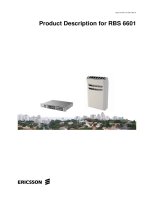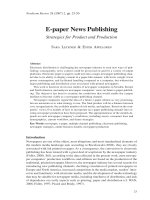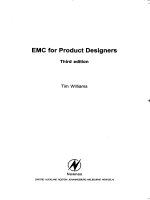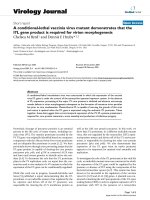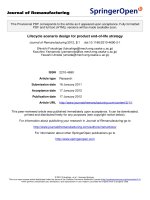Product Description for RBS 6601
Bạn đang xem bản rút gọn của tài liệu. Xem và tải ngay bản đầy đủ của tài liệu tại đây (707.03 KB, 26 trang )
1/221 01-FGC 101 0571 Rev C
Product Description for RBS 6601
Product Description for RBS 6601
Contents:
1
1.1
1.2
Introduction............................................................................................ 3
RBS 6601 – Main remote Solution .......................................................... 4
Safe, Smart and Sound Going Forward .................................................. 4
2
2.1
2.2
2.3
2.4
RBS 6601 Hardware Architecture ........................................................ 5
RBS 6601 Main Unit ................................................................................ 6
Remote Radio Unit ................................................................................ 10
Optical Interface Link ............................................................................. 12
Site Solutions......................................................................................... 12
3
3.1
3.2
3.3
3.4
Applications for RBS 6601.................................................................. 13
Metropolitan Indoor Site ........................................................................ 13
Suburban Shelter Site ........................................................................... 14
Highway Coverage Site ......................................................................... 15
In-building Coverage Solution ............................................................... 16
4
4.1
4.2
Configurations ..................................................................................... 17
Radio Configurations ............................................................................. 17
Digital Unit Configurations ..................................................................... 20
5
5.1
5.2
5.3
5.4
Technical Specifications..................................................................... 21
RRU, Supported standards ................................................................... 21
Power Options ....................................................................................... 22
Dimensions ............................................................................................ 22
Weight ................................................................................................... 22
6
6.1
6.2
Environmental Capabilities................................................................. 23
Safety Standards ................................................................................... 23
Other Standards and Requirements ...................................................... 23
7
Abbreviations....................................................................................... 25
1/221 01-FGC 101 0571 Uen Rev C 2009-11-03
© Ericsson AB 2008
Commercial in confidence
2 (26)
Product Description for RBS 6601
1
Introduction
The RBS 6000 base station family is designed to meet the increasingly complex
challenges facing operators today. RBS 6000 is built with tomorrow’s technology
and at the same provide backwards-compatibility with the highly successful RBS
2000 and RBS 3000 product lines. RBS 6000 base stations offer a seamless,
integrated and environmentally friendly solution and a safe, smart and sound
roadmap for whatever tomorrow holds.
Figure 1 RBS 6000 base station family
RBS 6000 Series Key Features:
•
Path to sustainability: The RBS 6000 Series ensures a smooth migration
to new functionality and new technologies with existing sites and cabinets,
thus providing a path to sustained revenues and profits.
•
Power on demand: Reengineering the power supply and fully integrating it
into the system were key objectives in designing the RBS 6000 series.
The intelligent power supply provides power on demand that is exactly
matched to what is needed at any given moment, thus ensuring that
power consumption is kept to an absolute minimum.
•
Multi-standard: All RBS 6000 base stations support multiple radio
technologies.
•
Integrated simplicity: New multi-purpose cabinets, an innovative common
building practice for all components, modular design and an extremely
high level of integration bring the functionality and capacity of an entire
site down to the size of a cabinet
1/221 01-FGC 101 0571 Uen Rev C 2009-11-03
© Ericsson AB 2008
Commercial in confidence
3 (26)
Product Description for RBS 6601
1.1
RBS 6601 – Main remote Solution
RBS 6601 is a Main Remote solution, optimized to deliver high radio performance
for efficient cell planning in a wide range of indoor and outdoor applications. The
Main Remote RBS, in which each RRU is located near an antenna, reduces
feeder losses and enables the system to use the same high-performance network
features at lower output power, thereby lowering power consumption and both
capital and operational expenditure. Up to twelve Remote Radio Units (RRU) can
be connected to a Main Unit (MU) to match any site requirements. The small,
lightweight units are easily carried to site and offer simple and discrete installation
where space and access are decisive issues.
1.2
Safe, Smart and Sound Going Forward
The Main Remote concept is designed to support all technologies in virtually any
combination. This means that timing in network expansion is less critical and that
there is less risk in investment decisions, since base band and RRU capacity can
be added as it is needed for the technology that is in demand.
Like the other members of the RBS 6000 family, the Main Remote RBS 6601
provides a common transport network solution that supports a wide range of
technologies.
1/221 01-FGC 101 0571 Uen Rev C 2009-11-03
© Ericsson AB 2008
Commercial in confidence
4 (26)
Product Description for RBS 6601
2
RBS 6601 Hardware Architecture
The Main–Remote solution has the similar architecture as the other products in
the RBS 6000 family.
The main Remote Solution is divided into a Main Unit (MU) and multiple Remote
Radio Unit (RRU) that are connected to the MU through optical fiber cables.
Figure 2 RBS 6601, Main Unit (MU) and Remote Radio Unit (RRU)
Figure 3 RBS 6601 3-sector site
1/221 01-FGC 101 0571 Uen Rev C 2009-11-03
© Ericsson AB 2008
Commercial in confidence
5 (26)
Product Description for RBS 6601
2.1
RBS 6601 Main Unit
The RBS 6601 Main Unit is indoor specified.
2.1.1
RBS 6601 - Indoor Main Unit
The RBS 6601 Main Unit is designed for indoor environments, preferably
mounted in a 19-inch rack. One DUW or two DUG/DUL can be housed in one
RBS 6601 Main Unit.
Some of the key characteristics of the RBS 6601 Main Unit are:
•
Power distribution of -48 VDC to Digital Units
•
Climate system including built-in fans and control part
In addition to the above RBS 6601 Main Unit also provides a limited number of
built-in customer alarm connections as well as connection to an external Support
Alarm Unit (SAU).
RRU connectors
Transmission connectors
GPS connector
O&M and control connectors
Power distribution unit
Figure 4 RBS 6601 Main Unit with DUG/DUL
1/221 01-FGC 101 0571 Uen Rev C 2009-11-03
© Ericsson AB 2008
Commercial in confidence
6 (26)
Product Description for RBS 6601
RRU connectors
Power distribution unit
Transmission connectors
GPS connector
O&M and control connectors
Figure 5 RBS 6601 Main Unit with DUW
2.1.2
Digital Unit for GSM
The Digital Unit GSM, DUG 20 can control up to 12 GSM carriers. If more than 12
TRXs are required, then an additional DUG can be installed in the RBS 6601
Main Unit and synchronized with the other DUG in the Main Unit.
The DUG supports the cross-connection of individual time slots to specific TRXs
and extracts the synchronization information from the Pulse-Code Modulation
(PCM) link to generate a timing reference for the RBS.
The DUG 20 supports:
•
E1/T1 transmission interface
•
Baseband processing
•
Link Access Procedures on D-Channel (LAPD) concentration /
multiplexing
•
Abis optimization
•
Multi-drop (cascading)
•
Synchronized radio network, through an external GPS receiver
•
Transceiver Group (TG) synchronization
•
Site LAN
1/221 01-FGC 101 0571 Uen Rev C 2009-11-03
© Ericsson AB 2008
Commercial in confidence
7 (26)
Product Description for RBS 6601
2.1.3
Digital Unit for WCDMA
The Digital Unit WCDMA (DUW) comes in three variants, DUW 10/20/30,
depending on capacity demand.
The DUW contains the baseband, control, and switching, as well as the Iub and
Mub interfaces. The DUW can handle different time-varying traffic mixes
consisting of voice circuit-switched data, packet-switched data, and high-speed
data such as High Speed Packet Access (HSPA).
Baseband resources are pooled in the DUW and the number of Channel
Elements (CE) and high-speed data capacity can be optimized to fit operator
requirements for user type and number of services.
The baseband capacity is pooled independently of sectors and frequencies. Two
baseband pools can exist (two DUW). Each DUW is then housed in one 19”, 1.5U
RBS 6601 Main Unit. The two DUW in two separate 19” 1.5U RBS 6601 Main
Units can be configured as one RBS node.
The DUW stabilizes the clock signal extracted from the transport network
connection or optional external GPS equipment and uses it to synchronize the
RBS.
The DUW provides:
•
100/1000 Base-T Ethernet
•
Channelised STM-1 transport network interface
•
Four IMA capable E1/T1/J1 ports
The DUW can connect to RRU22, RRUW or RRUS.
1/221 01-FGC 101 0571 Uen Rev C 2009-11-03
© Ericsson AB 2008
Commercial in confidence
8 (26)
Product Description for RBS 6601
2.1.4
Digital Unit for LTE
The DUL contains the baseband, control, and switching, as well as the S1 and
Mub interfaces for LTE RBS. The DUL supports different time-varying traffic
mixes over the LTE high-speed data interface.
Baseband resources are pooled in the DUL and the high-speed data capacity can
be optimized to fit operator requirements for user type and number of services.
The baseband capacity is pooled independently of sectors and frequencies, and
up to two baseband pools can exist (two DUL) in one 19” 6601 Main Unit with a
height of 1.5U and act as one RBS node.
The DUL stabilizes the clock signal extracted from the transport network
connection or optional external GPS equipment and uses it to synchronize the
RBS.
The DUL provides:
•
Full IP connectivity
•
A gigabit Ethernet transport network interface
1/221 01-FGC 101 0571 Uen Rev C 2009-11-03
© Ericsson AB 2008
Commercial in confidence
9 (26)
Product Description for RBS 6601
2.2
Remote Radio Unit
2.2.1
RRUW & RRUS
Figure 6, Remote Radio Unit (RRUW/RRUS)
RRUW and RRUS are designed to be installed close to the antennas, and can be
either wall or pole mounted. The RRUW has got WCDMA capability. RRUS is
Multi Standard Radio, MSR, capable. This means that RRUS is capable of
running GSM, WCDMA and LTE on the same RRU HW. Standard can be
changed by software reload.
The RRUS is HW prepared for running mixed mode configurations, i.e. to run 2
standards simultaneously. The standards supported in each frequency variant of
RRUS depend on which frequencies each standard is defined in 3GPP. A table
with standards supported for each frequency is found in chapter 5.1.
For GSM and LTE, up to 12 RRUS can be connected to one MU. For WCDMA,
up to 12 RRUW or RRUS can be connected to the same MU.
The RRUW & RRUS sustainable average output power is 60 W, for very large
coverage and high capacity requirements. Dual band configurations are also
supported by connecting RRUW or RRUS for different frequency bands to the
same MU.
The RRUW & RRUS contain most of the radio processing hardware. The main
parts of the RRU are the:
•
Transceiver (TRX)
•
Transmitter (TX) amplification
•
Transmitter/Receiver (TX/RX) duplexing
•
TX/RX filtering
•
Voltage Standing Wave Ratio (VSWR) support
•
ASC, TMA & RET support
•
Optical interface
1/221 01-FGC 101 0571 Uen Rev C 2009-11-03
© Ericsson AB 2008
Commercial in confidence
10 (26)
Product Description for RBS 6601
All connections are located at the bottom of the RRUW & RRUS.
TMAs or ASCs are normally not needed when the RRU is mounted near the
antenna. Still to maximize the flexibility at site RRUW & RRUS has support for
ASC, TMA and Remote Electrical Tilt (RET).
2.2.2
RRU22
Figure 7, Remote Radio Unit (RRU22 20W & 40W)
The RRU22 are WCDMA capable and designed to be installed close to the
antennas, either wall or pole mounted. Up to six RRU22 can be connected to the
same MU to match any site type.
Different types of RRU22 are available with respect to frequencies and output
power (20 or 40 W). It is possible to mix different RRU types in the same
configuration. Dual band configurations are supported by connecting RRU for
different frequency bands to the same MU.
The RRU contain most of the radio processing hardware. The main parts of the
RRU are the:
•
Transceiver (TRX)
•
Transmitter (TX) amplification
•
Transmitter/Receiver (TX/RX) duplexing
•
TX/RX filtering
•
Voltage Standing Wave Ratio (VSWR) support (40W)
•
ASC, TMA & RET support (see table below)
•
Optical interface
All connections are located at the bottom of the RRU.
TMA or ASC are normally not needed when the RRU is mounted near the
antenna. Some of the RRU types however have support for ASC, TMA, RET and
RET Interface Unit (RIU). The compatibility for the different RRU is presented in
the table below.
1/221 01-FGC 101 0571 Uen Rev C 2009-11-03
© Ericsson AB 2008
Commercial in confidence
11 (26)
Product Description for RBS 6601
RRU Type
ASC/TMA
RRU22 20 W
RRU22 40 W
RET
RIU
X
X
X(1)
X(2)
(1) Possible if connected via ASC
(2) Only needed when no ASC is used
2.3
Optical Interface Link
The RRU are connected to the MU through optical fiber cables. The length
between the RBS 6601 MU and a RRUW or RRUS can be as long as up to 40
km.
The units can be connected to each other in several different ways depending on
the site setup. The RBS 6601 supports:
•
Star connection of the RRU, where each RRU is connected to the MU.
•
RRUW & RRUS support cascade connections, where only one fiber cable
is connected between the MU and one of the RRU. The other RRU are
then connected to each other. This solution reduces the length of the
optical fiber cable needed and can be used in multiple applications when
the RRU are located far away from the MU.
•
The RRU22 can be connected as the last RRU in a RRU cascade chain.
2.4
Site Solutions
2.4.1
Support Alarm Unit
The optional Site Alarm Unit (SAU) monitors and controls customer equipment.
The SAU can handle up to 32 external alarms and four output control ports.
2.4.2
GPS
The RBS can be optionally connected to a GPS unit, which is used for
synchronization of the RBS.
For more Main Remote site solution information please see the Main Remote site
installation document.
1/221 01-FGC 101 0571 Uen Rev C 2009-11-03
© Ericsson AB 2008
Commercial in confidence
12 (26)
Product Description for RBS 6601
3
Applications for RBS 6601
The RBS 6601 offers a wide spectrum of indoor applications. It is well suited for
medium- to large capacity needs and is easy and flexible to set up.
3.1
Metropolitan Indoor Site
Figure 8 Metropolitan Indoor Site
The RBS 6601 is perfectly suited for metropolitan locations, with medium to large
capacity needs and requirements for low power consumption. The small subunits
are ideal for sites where access is limited or when site installation would result in
an undesirable level of disturbance, as the included units can be carried using
elevators or stairwells by hand.
The RRUs are mounted close to the antennas and the MU can be installed in an
existing 19-inch rack or wall-mounting kit in an equipment room.
1/221 01-FGC 101 0571 Uen Rev C 2009-11-03
© Ericsson AB 2008
Commercial in confidence
13 (26)
Product Description for RBS 6601
3.2
Suburban Shelter Site
Figure 9 Suburban Shelter Site
The RBS 6601 is a perfect solution for achieving coverage and capacity in
suburban environments. The Main Remote RBS 6601 provides wide area
coverage where expansion can be implemented in a cost efficient way.
Radio sites in remote areas with limited access to power infrastructure can benefit
from the Main Remote RBS 6601, since it offers low power consumption and high
efficiency at the same time.
The MU can be installed in an existing 19” rack in a small shelter below the tower,
and each RRU is installed close to the antennas in the tower top.
1/221 01-FGC 101 0571 Uen Rev C 2009-11-03
© Ericsson AB 2008
Commercial in confidence
14 (26)
Product Description for RBS 6601
3.3
Highway Coverage Site
Figure 10 Highway Coverage Site
Cost-effective coverage and capacity, low power consumption, and simplified civil
works make the RBS 6601 an ideal choice for highway coverage sites. The RRU
can be spread out along the highway where they easily can be mounted on
roadside poles, with negligible footprints, to minimize the interference on the
surroundings. The MU is mounted in a shelter with a 19” rack.
1/221 01-FGC 101 0571 Uen Rev C 2009-11-03
© Ericsson AB 2008
Commercial in confidence
15 (26)
Product Description for RBS 6601
3.4
In-building Coverage Solution
Figure 11 In-Building Coverage Solution
Using the RRU as a driver and connected to a Distributed Antenna System
(DAS), the RBS 6601 is a good candidate when deploying in-building coverage.
The possibility to spread out the RRU result in that one RBS can provide several
buildings with exclusively tailored coverage.
This solution can preferable be deployed in locations such as shopping centers,
train stations and sport arenas.
1/221 01-FGC 101 0571 Uen Rev C 2009-11-03
© Ericsson AB 2008
Commercial in confidence
16 (26)
Product Description for RBS 6601
4
Configurations
4.1
Radio Configurations
The RRU22 is a WCDMA capable radio unit.
RRU22 Configuration
Bandwidth
WCDMA
2 carriers
Technology
Output Power*
MCPA
20/40 W
Technology
Output Power*
MCPA
20/40/60 W
The RRUW is a WCDMA capable radio unit.
RRUW Configuration
Bandwidth
WCDMA
4 carriers
The RRUS is a multi-standard unit and can amplify two standards simultaneously.
Configuration
Bandwidth
Technology
Output Power*
GSM High capacity
4 TRXs
MCPA
20/40/60 W
WCDMA
4 carriers
MCPA
20/40/60 W
LTE
20 MHz
MCPA
20/40/60 W
* Output power from the antenna reference point. The output power and number of cell
carriers/bandwith for RBS with RRUW or RRUS are set by use of HW activation codes.
For radio performance information please see RBS 6000 Radio Performance and
RBS 3000 Radio Performance (for RRU22) in the Product Catalogue.
4.1.1
GSM with MCPA
Example configurations
Configuration **
Number of RRUS
Output power per TRX*
3×4
3
20 W
3×8
6
20 W
6×4
6
20 W
* Configured nominal output power.
** In order to run 4 carriers @ 20W per RRUS, GSM BSS features are needed.
See 45/221 04 – FGC 101 912 “GSM MCPA Intelligent Power Management” for more information.
Asymmetrical configurations of sectors and TRXs are supported.
1/221 01-FGC 101 0571 Uen Rev C 2009-11-03
© Ericsson AB 2008
Commercial in confidence
17 (26)
Product Description for RBS 6601
4.1.2
GSM Dualband with MCPA
Example configurations
Configuration
Number of Radio Units
Output Power per TRX
3I3
20 W / 43 dBm
3×4 I 3×4
4.1.3
WCDMA
Example configurations with RRUW or RRUS
Configuration
Number of Radio Units
Output Power per Cell Carrier (W)
3×1
3
20 / 40 / 60
3×1 MIMO
6
20+20 / 40+40 / 60+60
3×2
3
10 / 20 / 30
3×2
6
20 / 40 / 60
3×2 MIMO
6
10+10 / 20+20 / 30+30
3×3
3
20
3×3 MIMO
6
20+20
3×4
3
15
3×4
6
20 / 30
3×4 MIMO
6
15+15
6×1
6
20 / 40 / 60
6×2
6
10 / 20 / 30
Asymmetric configuration of sectors and TRXs is also supported. MIMO: e.g. 20+20 means 20 W
per TX branch.
For examples of configurations with RRU22 please see RBS 3418 Product Description.
4.1.4
WCDMA Dualband
This table shows example of dualband configurations with the 1900 and 850 MHz
frequency bands.
Example configurations with RRUW or RRUS
Configuration
Number of Radio Units
Output power per cell carrier (W)
3×1 I 3×1
3I3
20 / 40 / 60
20 / 40 / 60
3×1 I 3×2
3I3
20 / 40 / 60
10 / 20 / 30
3×2 I 3×2
3I3
10 / 20 / 30
10 / 20 / 30
1/221 01-FGC 101 0571 Uen Rev C 2009-11-03
© Ericsson AB 2008
Commercial in confidence
18 (26)
Product Description for RBS 6601
4.1.5
LTE
Example configurations
Configuration
Output power (W)
3×20 MHz
3
60
3×20 MHz MIMO
6
60 + 60
6×20 MHz
4.1.6
Number of Radio Units
6
60
LTE Dualband
Example configurations
Configuration
3×20 MHz I 3×20 MHz
1/221 01-FGC 101 0571 Uen Rev C 2009-11-03
Number of Radio Units
Output power (W)
3I3
60 I 60
© Ericsson AB 2008
Commercial in confidence
19 (26)
Product Description for RBS 6601
4.2
Digital Unit Configurations
4.2.1
GSM
Configuration
DUG 20
12
TRX
4.2.2
2*DUG 20
24
WCDMA
Configuration
DUW 10
DUW 20
DUW 30
2*DUW 30
6
6
6
12
128/128
384/384
768/512
1536/1024
DL Peak Throughput (Mbps)
42
126
252
504
UL Peak Throughput (Mbps)
12
36
48
96
Cell carriers
Channel Elements,
(Downlink/Uplink)
4.2.3
LTE
Configuration
DUL 20
DL Peak Throughput (Mbps)
173
UL Peak Throughput (Mbps)
56
Number of users
4.2.4
1000
Transport Network Interfaces
Max # of DU
in MU
E1/T1
DUG 20
2
4
DUW 10/20/30
1
DUL 20
2
Digital Unit
E1/T1/J1
STM-1
100/1000 BaseT Ethernet
4
1
1
1
Additional interfaces and transport network configurations are available as
options.
1/221 01-FGC 101 0571 Uen Rev C 2009-11-03
© Ericsson AB 2008
Commercial in confidence
20 (26)
Product Description for RBS 6601
5
Technical Specifications
5.1
RRU, Supported standards
RRU22
Frequency
WCDMA
800 (B5)
x
900E (B8)
x
1700/2100 (B4)
x
1700/1800 (B9)
x
1900 (B2)
x
2100 (B1)
x
RRUW
Frequency
WCDMA
800 (B5)
x
1900 (B2)
X
2100 (B1)
X
RRUS
Frequency
GSM
WCDMA
LTE
x
x
x
x
x
x
x
x
x
x
x
x
x
x
2100 (B1)
x
x
2600 (B7)
x
x
700 (B12)
800 (B5)
x
900P (B0)
x
900E (B8)
x
1700/2100 (B4)
1800 (B3)
x
1700/1800 (B9)
1900 (B2)
1/221 01-FGC 101 0571 Uen Rev C 2009-11-03
x
© Ericsson AB 2008
Commercial in confidence
21 (26)
Product Description for RBS 6601
5.2
Power Options
Unit
Nominal Voltage
MU
−48 VDC
RRU
−48 V DC / 100–250 V AC *
* AC option comes with AC/DC converter outside RRU.
For power consumption information please see RBS 6000 Power Consumption
and battery backup dimensioning guideline in the Product Catalogue.
5.3
Dimensions
The dimensions presented below refer to RRUS without the optional sun shield.
Unit
Width
Depth
MU (RBS 6601)
66 mm
482 mm
350 mm
RRU22 20W
410 mm
334 mm
176 mm
RRU22 40W
514 mm
334 mm
176 mm
RRUW & RRUS
5.4
Height
600 mm
350 mm
112 mm
Weight
Unit
Weight
MU (RBS 6601 with one DUG or DUL)
9 kg
MU (RBS 6601 with one DUW)
10.5 kg
RRU22 20W
19 kg (without Sunshield)
RRU22 40W
24 kg (without Sunshield)
RRUW & RRUS
20 kg (without Sunshield)
1/221 01-FGC 101 0571 Uen Rev C 2009-11-03
© Ericsson AB 2008
Commercial in confidence
22 (26)
Product Description for RBS 6601
6
Environmental Capabilities
This section contains a brief overview of standards, type approval, and
Electromagnetic Compatibility (EMC).
6.1
Safety Standards
In accordance with market requirements, the RBS 6000 complies with the
following product safety standards and directives:
Product Safety Compliance
EU Directives: 73/23/EEC Low Voltage Directive
Code of Federal Regulation 21 CFR 1040.10 and 1040.11
EN 60 950-1/IEC 60 950-1:2001 and IEC 60 950:1999
EN 60 215/IEC 60 215:1987
ANSI/UL 60 950-1/CSA C22.2 No. 60 950-1-03
IEC 60 825-1/EN 60 825-1
6.2
Other Standards and Requirements
6.2.1
Electromagnetic Compatibility
The RBS complies with European Community requirements regarding EMC. The
product is labeled with the CE mark in order to show compliance with the legal
requirements.
6.2.2
Product Approval Standards
The RBS complies with European Community requirements regarding radio
performance. The product is labeled with the CE mark in order to show
compliance with the legal requirements.
1/221 01-FGC 101 0571 Uen Rev C 2009-11-03
© Ericsson AB 2008
Commercial in confidence
23 (26)
Product Description for RBS 6601
6.2.3
Earthquake Resistance
The RBS 6601 Main Unit is designed to withstand exposure to seismic activity in
accordance with test method IEC/EN 60 068-2-57. The table below shows the
vibration resistance.
Vibration Resistance
Normal operation
Max. 0.02 m2/s3
Exceptional operation
Max. 0.08 m2/s3
Non-destructive
Max. 0.15 m2/s3
Shock
6.2.4
Specification
Max. 30 m/s2
Acoustic Noise
Unit
Temperature
RRU22 40 W
Sound Power Level
+40ºC
< 43 dBA
Room temperature
< 38 dBA
RRU22 20W, RRUW & RRUS generates no acoustic noise.
6.2.5
Operational Requirements
This section describes the operational environment for the RBS 6601.
Unit
Temperature Range
Relative Humidity
MU
+5ºC to +50ºC
5–85%
RRU22 20W
-33ºC to +50ºC
5–100%
RRU22 40W
-33ºC to +50ºC
5–100%
RRUW & RRUS
−40ºC to +55ºC
5–100%
1/221 01-FGC 101 0571 Uen Rev C 2009-11-03
© Ericsson AB 2008
Commercial in confidence
24 (26)
Product Description for RBS 6601
7
Abbreviations
Abbreviation
Meaning
AC
Alternating Current
ACCU
AC Connection Unit
ASC
Antenna System Controller
ATM
Asynchronous Transfer Mode
CE
Channel Elements
DC
Direct Current
DCCU
DC Connection Unit
DU
Digital Unit
EMC
Electromagnetic Compatibility
HSPA
High Speed Packet Access
GSM
Global System for Mobile communications
LTE
Long Term Evolution
MU
Main Unit
PDU
Power Distribution Unit
PSU
Power Supply Unit
RBS
Radio Base Station
RET
Remote Electrical Tilt
RRU
Radio Remote Unit
RU
Radio Unit
RX
Receiver
TMA
Tower Mounted Amplifier
VSWR
Voltage Standing Wave Ratio
WCDMA
Wideband Code Division Multiple Access
1/221 01-FGC 101 0571 Uen Rev C 2009-11-03
© Ericsson AB 2008
Commercial in confidence
25 (26)
